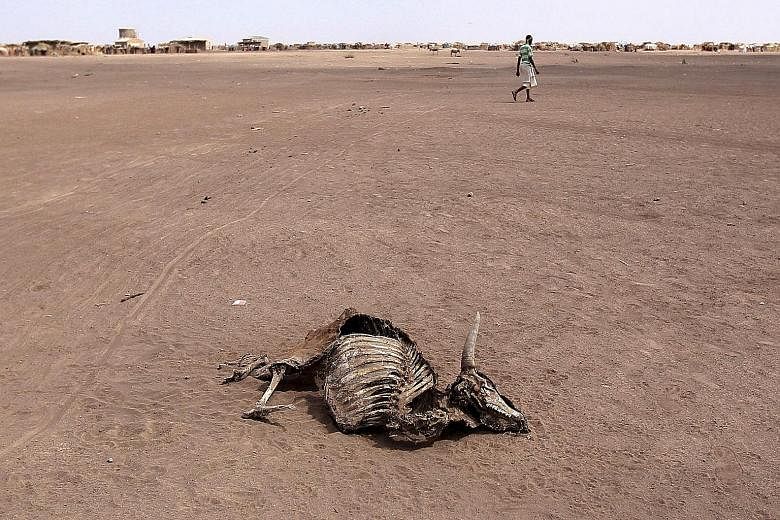ADDIS ABABA • Ethiopia is struggling with its worst drought in 30 years, with millions in dire need of life-saving aid, United Nations Secretary-General Ban Ki Moon warned yesterday.
At least 10.2 million people need food aid in Ethiopia, a figure the UN has warned could rise sharply, as "forecasts indicate that it could double within months", casting a fifth of the population into hunger.
Floods and failed rains caused by the El Nino weather phenomenon have sparked a dramatic rise in the number of people going hungry in large parts of Africa, with Ethiopia of special concern.
"People of the country are facing the worst drought in 30 years... the scale of emergency is too much for any single government," Mr Ban told reporters in the Ethiopian capital. "Immediate support will save lives and also support the impressive development that Ethiopia has made during the last decade."
Ethiopian Deputy Prime Minister Demeke Mekonnen warned his country had less than half of the US$1.4 billion (S$1.9 billion) needed. "Last year, Ethiopia was hit by one of the strongest El Nino events on record... the scale and severity of humanitarian needs have significantly increased," he said.
"The scale of the need is really huge and has outstripped the Ethiopian government's ability to do this on their own," Ms Carolyn Wilson, the chief executive of charity Save the Children, said after touring some of the afflicted regions in the country's north and east.
The World Food Programme said last week that about US$500 million was needed by the end of this month to extend the aid effort beyond April.
Food insecurity is a sensitive issue in Ethiopia, Africa's second-most populous nation, which enjoys near double-digit economic growth but has struggled to change its image following famine in 1984-85 after extreme drought.
"Those who remember Ethiopia in the 1980s may feel a disturbing sense of deja vu," the UN Office for the Coordination of Humanitarian Affairs said in a report last month. "The country is once again facing devastating climatic conditions: rains have failed; millions of people need food aid; children are suffering from severe malnutrition."
Thousands have left the hardest-hit regions, with refugees travelling across the Gulf of Aden to Yemen, despite the conflict raging there. Nearly 100,000 Ethiopians and Somalis travelled by boat to Yemen last year, according to the UN.
El Nino is triggered by a warming of sea surface temperatures in the Pacific Ocean. It can cause unusually heavy rains in some parts of the world and drought elsewhere.
In southern Africa, around 14 million people face going hungry after a prolonged drought wrecked harvests, with Malawi among the worst-hit countries. Little rainfall last year has left 2.8 million people in Malawi facing hunger.
About 1.9 million people in Madagascar and 1.5 million in Zimbabwe, where last year's harvest was half that of the previous year, face the same problem.
In war-torn South Sudan, bordering Ethiopia, UN-backed experts warned late last year of a "concrete risk of famine", with tens of thousands of people feared to be starving to death outside areas aid workers can reach.
Some aid has been delivered, but civilians report dire conditions. The conflict has triggered a humanitarian crisis, with 2.3 million people forced from their homes and five million - around half the population - in need of emergency food aid.
AGENCE FRANCE-PRESSE, REUTERS

